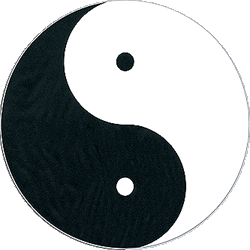
 The Greek term 'syzygos', syzygy, which meant for the Classical and Hellenic Greeks either 'marriage' or 'sexual union', had, like the term 'gnosis', a special meaning for the Gnostics. In Gnostic creation, the production of the World was brought about by the Aions, originally six emmanations of the Father Creator and always occuring in androgynous pairs--syzygies. For Poimanders, these are the Seven Planets, arranged as Saturn/Chronos (Father Time) and the syzygial pairs Jupiter and the Moon (Juno), Mars and Venus, and the Sun and Mercury. For Valentinus there was Abyss, the Fore-Father from whose Thought, called Silence, emmanated Mind and Truth, Word and Life, and Man and Church, all in Male/Female pairs. Similarly, the Six Days of Creation and the Seventh Day of Rest in Genesis, though not syzygial in themselves, serve a purpose similar to the Aions--a word whose alternate form 'eon' means 'period of time'--and these Seven Days later became for the Qabbalists the Holy Palace in the center from which emmanate the Six Directions of Space. Eventually, these six became the syzygial spheerote of the Tree of Life, and are, in modern mathematical analysis, the three syzygial axes of our three-dimensional space. And again, in the developments of the religion of Zarathustra, conceived in Persia at about six-hundred years before the rise of Gnosticism but reformulated in subsequent centuries, Boundless Time--a term which in Greek would be rendered Aion--was the Father of Mazda--Wisdom (note the relationship to Gnosis, Sophia, Hokhmah)--whose six attributes, or Archons, produced the World. In the Zarathustrian system these six emmanations were naturally given Iranian names, three of which were masculine and three feminine; and in fact they were ultimately viewed as three male and three female Archangels. The Greek term 'syzygos', syzygy, which meant for the Classical and Hellenic Greeks either 'marriage' or 'sexual union', had, like the term 'gnosis', a special meaning for the Gnostics. In Gnostic creation, the production of the World was brought about by the Aions, originally six emmanations of the Father Creator and always occuring in androgynous pairs--syzygies. For Poimanders, these are the Seven Planets, arranged as Saturn/Chronos (Father Time) and the syzygial pairs Jupiter and the Moon (Juno), Mars and Venus, and the Sun and Mercury. For Valentinus there was Abyss, the Fore-Father from whose Thought, called Silence, emmanated Mind and Truth, Word and Life, and Man and Church, all in Male/Female pairs. Similarly, the Six Days of Creation and the Seventh Day of Rest in Genesis, though not syzygial in themselves, serve a purpose similar to the Aions--a word whose alternate form 'eon' means 'period of time'--and these Seven Days later became for the Qabbalists the Holy Palace in the center from which emmanate the Six Directions of Space. Eventually, these six became the syzygial spheerote of the Tree of Life, and are, in modern mathematical analysis, the three syzygial axes of our three-dimensional space. And again, in the developments of the religion of Zarathustra, conceived in Persia at about six-hundred years before the rise of Gnosticism but reformulated in subsequent centuries, Boundless Time--a term which in Greek would be rendered Aion--was the Father of Mazda--Wisdom (note the relationship to Gnosis, Sophia, Hokhmah)--whose six attributes, or Archons, produced the World. In the Zarathustrian system these six emmanations were naturally given Iranian names, three of which were masculine and three feminine; and in fact they were ultimately viewed as three male and three female Archangels.
|

